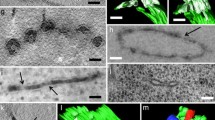Abstract
Golgi apparatus of both plant and animal cells are characterized by an extensive system of approximately 30 nm diameter peripheral tubules. The total surface area of the tubules and associated fenestrae is thought to be approximately equivalent to that of the flattened portions of cisternae. The tubules may extend for considerable distances from the stacks. The tubules are continuous with the peripheral edges of the stacked cisternae, but the way they interconnect differs across the stack. In plant cells, for example, tubules associated with the near-cis and mid cisternae often begin to anastomose close to the peripheral edges of the stacked cisternae, whereas the tubules of the trans cisternae are less likely to anastomose and are more likely to be directly continuous with the peripheral edges of the stacked cisternae. Additionally, the tubules may blend gradually into fenestrae that surround some of the stack cisternae. Because of the large surface area occupied by tubules and fenestrae, it is reasonable to suppose that these components of the Golgi apparatus play a significant role in Golgi apparatus function. Tubules clearly interconnect closely adjacent stacks of the Golgi apparatus and may represent a communication channel to synchronize stack function within the cell. A feasible hypothesis is that tubules may be a potentially static component of the Golgi apparatus in contrast to the stacked cisternal plates which may turn over continuously. The coated buds associated with tubules may represent the means whereby adjacent Golgi apparatus stacks exchange carbohydrate-processing enzymes or where resident Golgi apparatus proteins are introduced into and out of the stack during membrane flow differentiation. The limited gradation of tubules from cis to medial to trans offers additional possibilities for functional specialization of Golgi apparatus in keeping with the hypothesis that tubules are repositories of resident Golgi apparatus proteins protected from turnover during the flow differentiation of the flattened saccules of the Golgi apparatus stack.
Similar content being viewed by others
Author information
Authors and Affiliations
Additional information
Accepted: 3 November 1997
Rights and permissions
About this article
Cite this article
Mollenhauer, H., Morré, D. The tubular network of the Golgi apparatus. Histochemistry 109, 533–543 (1998). https://doi.org/10.1007/s004180050253
Issue Date:
DOI: https://doi.org/10.1007/s004180050253




